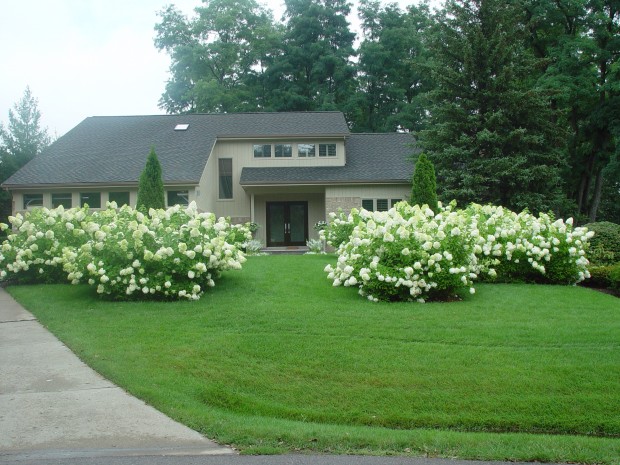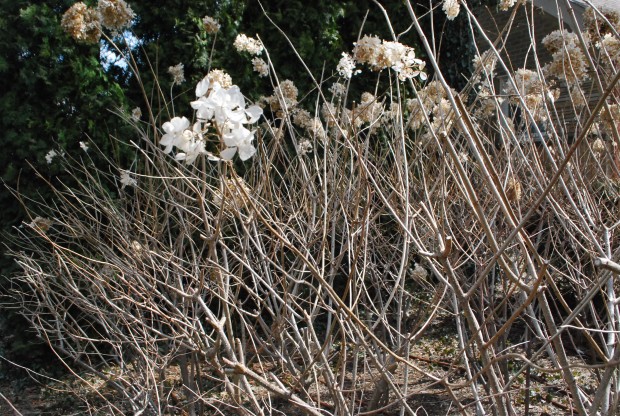The day you put a plant in the ground is the first day of a relationship. If you plant cosmos, that relationship constitutes one season. If you plant a tree, that relationship might survive for generations. If you plant shrubs, you could have a good many years of pleasure ahead of you-provided you prune. Woody shrubs, left to their own devices, go to rack and ruin. They spend no end of effort piling on enough wood to send the tips of their branches to the sky. What is the big attraction of the sky? No competition for light, air, and rain. No shrub feels any inclination to bloom where you want to see blooms-at eye level, that is. Plants grow with survival in mind. Should you have another idea in mind, wade in. Participate.
Shrubs will grow sideways, around an obstacle. They will sprout back, if cut to the ground. They will survive the indignity of a homeowner with a hedge trimmer gone amok. They will survive, even though the overall shape may be ungainly, or sheared to within an inch of its life. The instinct to live is strong. Lucky for me, and every other gardener who has learned on the job. Pruning a hydrangea is not hard-it just requires the patience to consider every branch, before you cut. I prune each branch, one at a time.
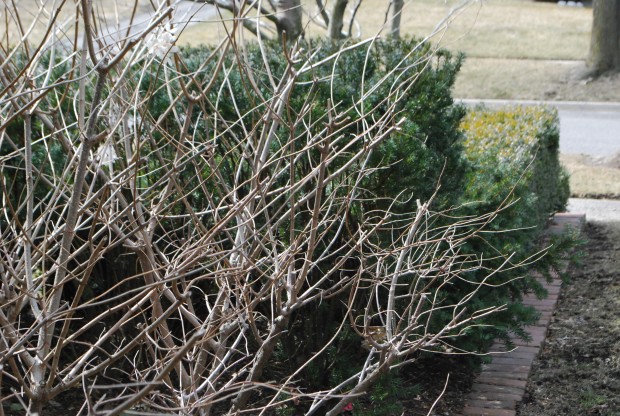
A well pruned hydrangea looks like it has had a shag haircut. Every branch has its our airspace. This means some branches get last year’s flowers cut off-only. Other branches get 8″ removed. Others get 16″ removed. Some old and thick branches in the middle get cut even harder, so air and light can reach down in to as many branches as possible. Some gardeners prune their Limelight hydrangeas to within 14″ to 24″ of the ground, forcing them to produce basal shoots which originate underground. This method tends to produce a shorter shrub, with fewer and larger flowers. I dislike cutting this hard-it takes so long for the shrub to regain a natural and airy shape. I would rather have lots of flowers, than a few gigantic flowers. I would rather plant the shorter growing version of Limelight- “Little Lime” – than prune a Limelight too hard.
I like my Limelight hydrangeas tall, and I like lots of flowers. My yews are 48″ tall at this end of the garden, and the arborvitae are 14′ tall. The hydrangeas grown 6′ to 8′ tall-perfect for this spot. For good flowering from top to bottom, the lower branches need to be left long, and the top branches need to be shorter. The finished shape should be very loosely pyramidal, or like an egg on its side. Step back frequently, to see how things are shaping up. This hydrangea blooms on new wood, so no matter how you prune, you will get flowers. Shearing a branch will encourage that branch to produce multiple shoots below the cut. Thicken up, and out. As long as the exterior shape is loosely described, the shrub will prosper. Shearing deciduous flowering shrubs may take less time, but produces less than desirable results. Renovating shrubs that have been sheared takes a long time. One cut at a time-this is my advice. Invest in a great pair of pruners-this makes the work easier. The moment that all I can hear is the birds, and the action of the pruner blades bypassing each other, is a spring gardening moment I treasure.
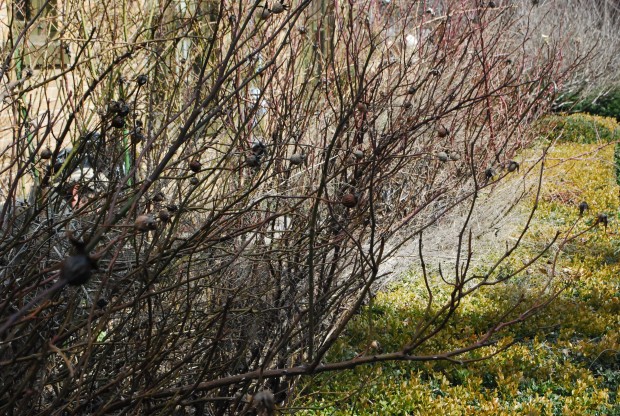 I do grow a few shrub roses. Sally Holmes, Carefree Beauty and Earthsong. I have read lots of articles about pruning roses, none of which I have paid much mind to. I stop dead heading my roses in mid-August. I actually love the rose hips in the fall and winter. In the spring, when the buds swell, I prune. The swelling of the buds? You will recognize swelling buds when you see them. My roses bloom on the new shoots. I never cut a branch back by more than 1/3rd. I prune the entire collection of roses as if they were a single plant. I leave them loose. Last fall I secured the summer’s growth of the climbing roses to the wall-not much needs to be done to them now.
I do grow a few shrub roses. Sally Holmes, Carefree Beauty and Earthsong. I have read lots of articles about pruning roses, none of which I have paid much mind to. I stop dead heading my roses in mid-August. I actually love the rose hips in the fall and winter. In the spring, when the buds swell, I prune. The swelling of the buds? You will recognize swelling buds when you see them. My roses bloom on the new shoots. I never cut a branch back by more than 1/3rd. I prune the entire collection of roses as if they were a single plant. I leave them loose. Last fall I secured the summer’s growth of the climbing roses to the wall-not much needs to be done to them now.
 Occasionally I will hard prune an old climbing rose cane low to the ground. This keeps new growth coming from the bottom. Pruning stimulates growth. Pruning a climbing rose cane 6 feet off the ground will result in a rash of shoots. A long stalk with a tuft of shoots on the top-not the best look. Any cane which you can train to grow horizontally will flower more heavily. If you think about the where the sun and rain comes from, this makes sense. Is the afore mentioned a guide to pruning roses-not really. Every gardener has to deal with their roses one to one. Look at them, and decide how to prune. I prune my roses so they have the best possible overall shape. Most roses are very ungainly growers, so pruning for a good shape is not always so easy. That’s why I grow asparagus with my roses. The ferny fronds conceal those awkward and ungainly branches. Do I prune my asparagus over the summer-oh yes. I keep them at a height which conceals those legs. Does this affect my asparagus crop? Maybe. But everything in the garden is about choices. I want great roses more than I want home grown asparagus.
Occasionally I will hard prune an old climbing rose cane low to the ground. This keeps new growth coming from the bottom. Pruning stimulates growth. Pruning a climbing rose cane 6 feet off the ground will result in a rash of shoots. A long stalk with a tuft of shoots on the top-not the best look. Any cane which you can train to grow horizontally will flower more heavily. If you think about the where the sun and rain comes from, this makes sense. Is the afore mentioned a guide to pruning roses-not really. Every gardener has to deal with their roses one to one. Look at them, and decide how to prune. I prune my roses so they have the best possible overall shape. Most roses are very ungainly growers, so pruning for a good shape is not always so easy. That’s why I grow asparagus with my roses. The ferny fronds conceal those awkward and ungainly branches. Do I prune my asparagus over the summer-oh yes. I keep them at a height which conceals those legs. Does this affect my asparagus crop? Maybe. But everything in the garden is about choices. I want great roses more than I want home grown asparagus.
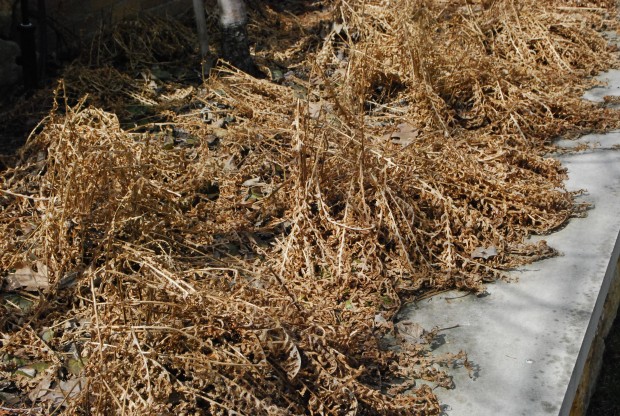 I do not cut back my beech ferns in the fall. The dead fronds mulch and protect the European ginger over the winter. By April 1st, those fronds have cut loose from the crown. I do not need to prune. I rake them off. A rubber rake does a great job. My fingers do the best job.
I do not cut back my beech ferns in the fall. The dead fronds mulch and protect the European ginger over the winter. By April 1st, those fronds have cut loose from the crown. I do not need to prune. I rake them off. A rubber rake does a great job. My fingers do the best job.
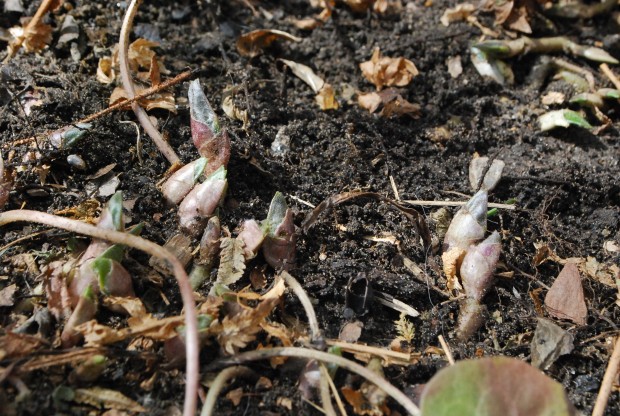 The European ginger has already been busy, sending out new shoots. A steel rake, or a size 8 boot can damage these tender new shoots. One of the pleasures of the spring-the new growth. Friable soil. My housekeeping inside-rather rude and abrupt. I just want to get the job done. When I am cleaning the garden in the spring, I take my time. I do it-gently. I have a relationship with this garden that I intend to nurture.
The European ginger has already been busy, sending out new shoots. A steel rake, or a size 8 boot can damage these tender new shoots. One of the pleasures of the spring-the new growth. Friable soil. My housekeeping inside-rather rude and abrupt. I just want to get the job done. When I am cleaning the garden in the spring, I take my time. I do it-gently. I have a relationship with this garden that I intend to nurture.
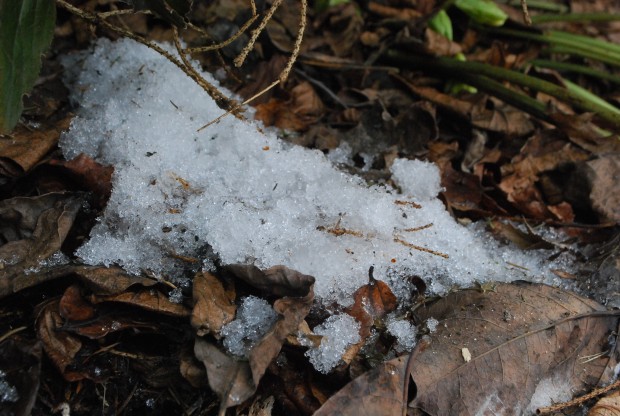
Lifting a lower branch of a spruce, I see icy snow. The transition from winter to spring has been incredibly slow this year. Really shady spots in my garden are still frozen. The night temperatures are still below freezing. Frozen ground, frozen branches-my advice is to let them be.
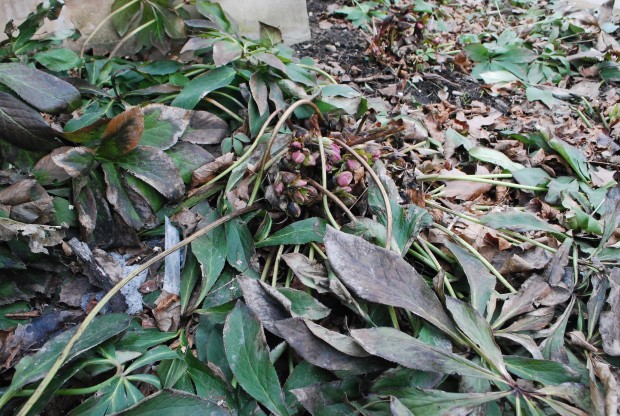 The hellebores are awake. Last years foliage has collapsed in a heap on the ground. Every day I think about cutting that old foliage away. Clean and bare is not always the best situation. The newly emerging flowers benefit from all that fluff. The transition from winter to spring can be a rocky journey. Sometimes, the best thing to do is to do nothing.
The hellebores are awake. Last years foliage has collapsed in a heap on the ground. Every day I think about cutting that old foliage away. Clean and bare is not always the best situation. The newly emerging flowers benefit from all that fluff. The transition from winter to spring can be a rocky journey. Sometimes, the best thing to do is to do nothing.
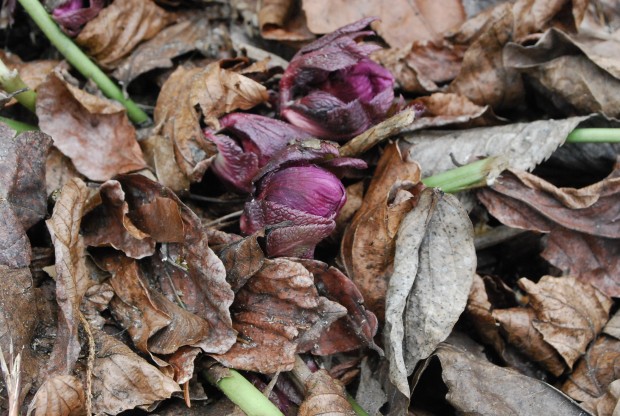 Last year’s foliage protects those flowering stalks, ready to emerge. A warm spell in March proved to be damaging. The buds sensed it was time to grow. Nature had a different idea in mind. We have had a run of really cold weather, the past 3 weeks. Some of the exposed buds on this plant are black with the rot produced by freezing temperatures.
Last year’s foliage protects those flowering stalks, ready to emerge. A warm spell in March proved to be damaging. The buds sensed it was time to grow. Nature had a different idea in mind. We have had a run of really cold weather, the past 3 weeks. Some of the exposed buds on this plant are black with the rot produced by freezing temperatures.
 Cutting away last years foliage exposes new flower buds. Very tender flower buds. Just to look at them, you would know they are not armed against the cold. I cut the dead leaves away, and put them back over the top of these buds. It is too soon to clean here. What constitutes better days? Warmer nights. The ground is still very cold. It will be 2 months before the soil really warms up in my zone. Hellebores do not require warm soil, but the flowers will be damaged by night air temperatures in the mid to low 20’s. They need all that litter on the ground over them. It’s not time yet to wash and put away the blanket.
Cutting away last years foliage exposes new flower buds. Very tender flower buds. Just to look at them, you would know they are not armed against the cold. I cut the dead leaves away, and put them back over the top of these buds. It is too soon to clean here. What constitutes better days? Warmer nights. The ground is still very cold. It will be 2 months before the soil really warms up in my zone. Hellebores do not require warm soil, but the flowers will be damaged by night air temperatures in the mid to low 20’s. They need all that litter on the ground over them. It’s not time yet to wash and put away the blanket.
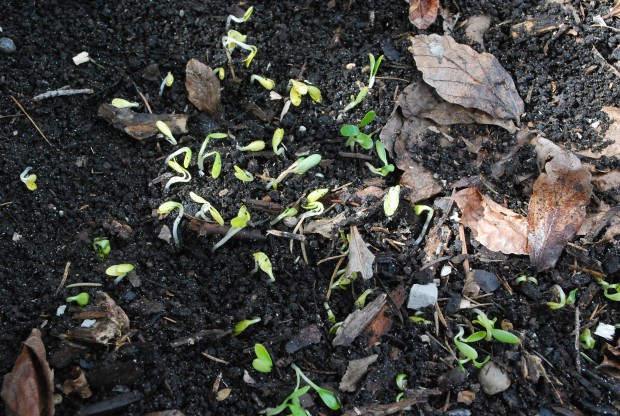 I am shocked and pleased to see that I have hellebore seedlings sprouting. I spent a few moments taking this in, before I covered them up. I am not sure how long it will be, before I expose them to the light of the new season. The pruning and the cleaning-all in good time. A slow spring-this is what we have now.
I am shocked and pleased to see that I have hellebore seedlings sprouting. I spent a few moments taking this in, before I covered them up. I am not sure how long it will be, before I expose them to the light of the new season. The pruning and the cleaning-all in good time. A slow spring-this is what we have now.
